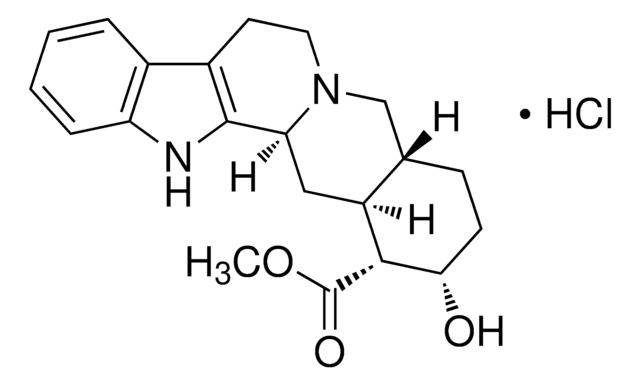R9525
RX 821002 hydrochloride
solid, ≥98% (HPLC)
Synonym(s):
2-[2-(2-Methoxy-1,4-benzodioxanyl)]imidazoline hydrochloride
About This Item
Recommended Products
Assay
≥98% (HPLC)
form
solid
storage condition
desiccated
color
white
solubility
H2O: >20 mg/mL
SMILES string
Cl[H].COC1(COc2ccccc2O1)C3=NCCN3
InChI
1S/C12H14N2O3.ClH/c1-15-12(11-13-6-7-14-11)8-16-9-4-2-3-5-10(9)17-12;/h2-5H,6-8H2,1H3,(H,13,14);1H
InChI key
IMPOOMVZVWKSAP-UHFFFAOYSA-N
Gene Information
human ... ADRA2A(150) , ADRA2B(151) , ADRA2C(152)
Biochem/physiol Actions
Signal Word
Warning
Hazard Statements
Precautionary Statements
Hazard Classifications
Eye Irrit. 2 - Skin Irrit. 2 - STOT SE 3
Target Organs
Respiratory system
Storage Class Code
11 - Combustible Solids
WGK
WGK 3
Flash Point(F)
Not applicable
Flash Point(C)
Not applicable
Personal Protective Equipment
Certificates of Analysis (COA)
Search for Certificates of Analysis (COA) by entering the products Lot/Batch Number. Lot and Batch Numbers can be found on a product’s label following the words ‘Lot’ or ‘Batch’.
Already Own This Product?
Find documentation for the products that you have recently purchased in the Document Library.
Articles
Learn about alpha-2 adrenoceptor and its subtypes, mediated responses, and applications of agonists. Included is a list of available products and a comparison table.
Learn about alpha-2 adrenoceptor and its subtypes, mediated responses, and applications of agonists. Included is a list of available products and a comparison table.
Learn about alpha-2 adrenoceptor and its subtypes, mediated responses, and applications of agonists. Included is a list of available products and a comparison table.
Learn about alpha-2 adrenoceptor and its subtypes, mediated responses, and applications of agonists. Included is a list of available products and a comparison table.
Our team of scientists has experience in all areas of research including Life Science, Material Science, Chemical Synthesis, Chromatography, Analytical and many others.
Contact Technical Service









